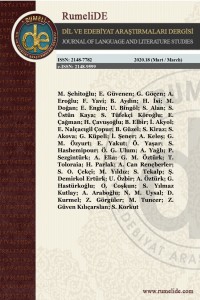Öz
Metinlerarasılık, bir metnin diğer metinlerle ilişkisini ifade eder. Kavramsal açıdan resim, heykel, mimari, sinema ve tiyatro gibi birçok sanat dalıyla ilintili olsa da bu çalışmada çeviri bilim bağlamında edebi bir kavram olarak ele alınacaktır. Alıntılar, atıflar ve anıştırmalar gibi metinlerarası araçlar derin bir kültürel bilgi ve metin dışı ilişkilere dair farkındalık gerektirdiğinden çevirmenler için büyük zorluklar doğurur. Bu metin dışı ilişkiler yazar tarafından anıştırma, alıntı, çeviri, öykünme, parodi ve diğer metinlerarası öğeler kullanılarak oluşturulabilir. Ancak, tüm bu öğelerin çözümlenmesi çevirmen için zorlayıcı görünmektedir. Bu nedenle, Dubliners eserinin Türkçe çevirilerinde metinlerarasılık özelliğinin nasıl ele alındığını incelemek için, konunun kapsamı anıştırmalarla sınırlandırılmıştır. Anıştırma, önceden bilinen bir edebi esere, şahsa, yer veya nesneye yapılan dolaylı bir gönderme olarak tanımlanmaktadır. Joyce Dublinliler eserinde edebi metinlere, tarihi ve politik şahıs ve olaylara ithafen birçok göndermeden yararlanır. Metin incelemesi aşamasında, kitaptaki on beş öykünün tamamındaki anıştırmalar ayrı ayrı tespit edilmiştir. Daha sonra Murat Belge ve Merve Tokmakçıoğlu tarafından yapılan Türkçe çeviriler analiz edilmiş ve tespit edilen her bir anıştırmanın Türkçe karşılığı listelenmiştir. Her iki metinde de tespit edilen öğeler, metinlerarası özelliklerden kaynaklanan problemleri çözmek için çevirmenlerin yararlandıkları stratejileri ortaya çıkarmak amacıyla karşılaştırılmıştır. Çeviri stratejilerinin belirlenmesi için Ritva Leppihalme’in (1997) önerdiği stratejilerden yararlanılmıştır.
Anahtar Kelimeler
Kaynakça
- Allen, G (2000). Intertextuality. London and New York: Routledge.
- Bakhtin, M. (1984). Problems of Dostoyevsky’s poetics. In C. Emerson (Ed.), Theory and History of Literature (Vol. 8). Minneapolis and London: University of Minnesota Press.
- Delahunty, A., Dignen, S., & Stock, P. (2001). The Oxford dictionary of allusions (1st ed.). New York: Oxford University Press.
- Genette, G. (1997). Palimpsests: Literature in the second degree. Lincoln: University of Nebraska Press.
- Gifford, D. (1981). Joyce annotated: Notes for "Dubliners" and "A Portrait of the Artist as a Young Man”. USA: University of California Press.
- Hatim, B., & Mason, I. (1990). Discourse and the translator. London: Longman.
- Hatim, B., & Mason, I. (1997). The translator as communicator. London: Routledge.
- Hervey, S., & Higgins, I. (1992). Thinking Translation. London & New York: Routledge.
- Joyce, J. (1987). Dublinliler (M. Belge, Çev.) İstanbul: İletişim Yayınları.
- Joyce, J. (2015). Dublinliler (M. Tokmakçıoğlu, Çev.) İstanbul: Aylak Adam.
- Joyce, J. (2018). Dubliners. Retrieved from https://www.planetebook.com/dubliners/.
- Lecuyer, M. L. (2009). Dante’s literary influence in Dubliners: James Joyce’s modernist allegory of paralysis. MA Thesis. USA: Iowa State University
- Leppihalme, R. (1997). Culture bumps: An empirical approach to the translation of allusions topics in translation. England: Multilingua Matters.
- Quinn, E. (2001). A dictionary of literary and thematic terms (2nd ed.). USA: Facts on File.
- Schäffner, C. (2012). Intercultural intertextuality as a translation phenomenon. Perspectives, 20(3), 345-364. doi: 10.1080/0907676X.2012.702402.
Öz
Intertextuality refers to the relation of a text to other texts. Although the notion has connections with many fields of art such as painting, sculpture, architecture, cinema and theatre, in this study it is examined as a literary concept within the framework of translation studies. Intertextual devices such as quotations, citations and allusions pose great challenge for translators as they require an extensive cultural knowledge and an awareness of the extratextual relations of the text. These relations can be built by author’s use of allusions, quotations, translation, pastiche, parody and other intertextual elements. However, the analysis of all these elements seems to be compelling for a translator. Therefore, to investigate how intertextuality is treated in the Turkish translations of Dubliners, the scope has been restricted to the allusions. Allusion is described as an indirect reference to a literary work, a person, place or thing that is already known. In Dubliners, Joyce uses multiple allusions dedicated to literary texts, historical and political figures and events. The case study has been carried out by examining the allusions separately in all fifteen stories within the book. After that, the Turkish translations performed by Murat Belge and Merve Tokmakçıoğlu were analysed, and the Turkish counterparts of the detected allusions were listed for each story. The detected items in both texts were compared to reveal the strategies used by the translators in order to solve the problems related to the intertextual aspects of the text. Ritva Leppihalme’s (1997) proposed strategies were adopted for the identification of translation strategies.
Anahtar Kelimeler
Kaynakça
- Allen, G (2000). Intertextuality. London and New York: Routledge.
- Bakhtin, M. (1984). Problems of Dostoyevsky’s poetics. In C. Emerson (Ed.), Theory and History of Literature (Vol. 8). Minneapolis and London: University of Minnesota Press.
- Delahunty, A., Dignen, S., & Stock, P. (2001). The Oxford dictionary of allusions (1st ed.). New York: Oxford University Press.
- Genette, G. (1997). Palimpsests: Literature in the second degree. Lincoln: University of Nebraska Press.
- Gifford, D. (1981). Joyce annotated: Notes for "Dubliners" and "A Portrait of the Artist as a Young Man”. USA: University of California Press.
- Hatim, B., & Mason, I. (1990). Discourse and the translator. London: Longman.
- Hatim, B., & Mason, I. (1997). The translator as communicator. London: Routledge.
- Hervey, S., & Higgins, I. (1992). Thinking Translation. London & New York: Routledge.
- Joyce, J. (1987). Dublinliler (M. Belge, Çev.) İstanbul: İletişim Yayınları.
- Joyce, J. (2015). Dublinliler (M. Tokmakçıoğlu, Çev.) İstanbul: Aylak Adam.
- Joyce, J. (2018). Dubliners. Retrieved from https://www.planetebook.com/dubliners/.
- Lecuyer, M. L. (2009). Dante’s literary influence in Dubliners: James Joyce’s modernist allegory of paralysis. MA Thesis. USA: Iowa State University
- Leppihalme, R. (1997). Culture bumps: An empirical approach to the translation of allusions topics in translation. England: Multilingua Matters.
- Quinn, E. (2001). A dictionary of literary and thematic terms (2nd ed.). USA: Facts on File.
- Schäffner, C. (2012). Intercultural intertextuality as a translation phenomenon. Perspectives, 20(3), 345-364. doi: 10.1080/0907676X.2012.702402.
Ayrıntılar
| Birincil Dil | İngilizce |
|---|---|
| Konular | Dilbilim, Sanat ve Edebiyat |
| Bölüm | Türk dili, kültürü ve edebiyatı |
| Yazarlar | |
| Yayımlanma Tarihi | 21 Mart 2020 |
| Yayımlandığı Sayı | Yıl 2020 Sayı: 18 |


